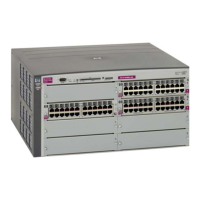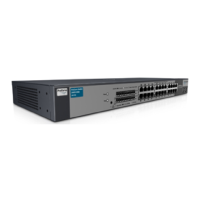OSPF 111
Assigning the area index
The aindex <area index> option is actually just an arbitrary index (0-2) used only by the switch. This index does not
necessarily represent the OSPF area number, though for configuration simplicity, it should where possible.
For example, both of the following sets of commands define OSPF area 0 (the backbone) and area 1 because that
information is held in the area ID portion of the command. However, the first set of commands is easier to maintain
because the arbitrary area indexes agree with the area IDs:
• Area index and area ID agree
/cfg/l3/ospf/aindex 0/areaid 0.0.0.0 (Use index 0 to set area 0 in ID octet format)
/cfg/l3/ospf/aindex 1/areaid 0.0.0.1 (Use index 1 to set area 1 in ID octet format)
• Area index set to an arbitrary value
/cfg/l3/ospf/aindex 1/areaid 0.0.0.0 (Use index 1 to set area 0 in ID octet format)
/cfg/l3/ospf/aindex 2/areaid 0.0.0.1 (Use index 2 to set area 1 in ID octet format)
Using the area ID to assign the OSPF area number
The OSPF area number is defined in the areaid <IP address> option. The octet format is used in order to be
compatible with two different systems of notation used by other OSPF network vendors. There are two valid ways to
designate an area ID:
• Placing the area number in the last octet (0.0.0.n)
Most common OSPF vendors express the area ID number as a single number. For example, the Cisco IOS-
based router command “network 1.1.1.0 0.0.0.255 area 1” defines the area number simply as
“area 1”. On the GbE2c, using the last octet in the area ID, “area 1” is equivalent to “areaid 0.0.0.1”.
• Multi-octet (IP address)
Some OSPF vendors express the area ID number in multi-octet format. For example, “area 2.2.2.2”
represents OSPF area 2 and can be specified directly on the GbE2c as “areaid 2.2.2.2”.
NOTE: Although both types of area ID formats are supported, be sure that the area IDs are in the same format
throughout an area.
Attaching an area to a network
Once an OSPF area has been defined, it must be associated with a network. To attach the area to a network, you
must assign the OSPF area index to an IP interface that participates in the area. The format for the command is as
follows:
>> # /cfg/l3/ospf/if <interface number>/aindex <area index>
For example, the following commands could be used to configure IP interface 14 for a presence on the
10.10.10.1/24 network, to define OSPF area 1, and to attach the area to the network:
>> # /cfg/l3/if 14 (Select menu for IP interface 14)
>> IP Interface 14# addr 10.10.10.1(Define IP address on backbone
network)
>> IP Interface 14# mask 255.255.255.0(Define IP mask on backbone)
>> IP Interface 14# ena (Enable IP interface 14)
>> IP Interface 14# ../ospf/aindex 1(Select menu for area index 1)
>> OSPF Area (index) 1 # areaid 0.0.0.1(Define area ID as OSPF area 1)
>> OSPF Area (index) 1 # ena (Enable area index 1)
>> OSPF Area (index) 1 # ../if 14 (Select OSPF menu for interface 14)
>> OSPF Interface 14# aindex 1 (Attach area to network on
interface 14)
>> OSPF Interface 14# enable (Enable interface 14 for area index 1)

